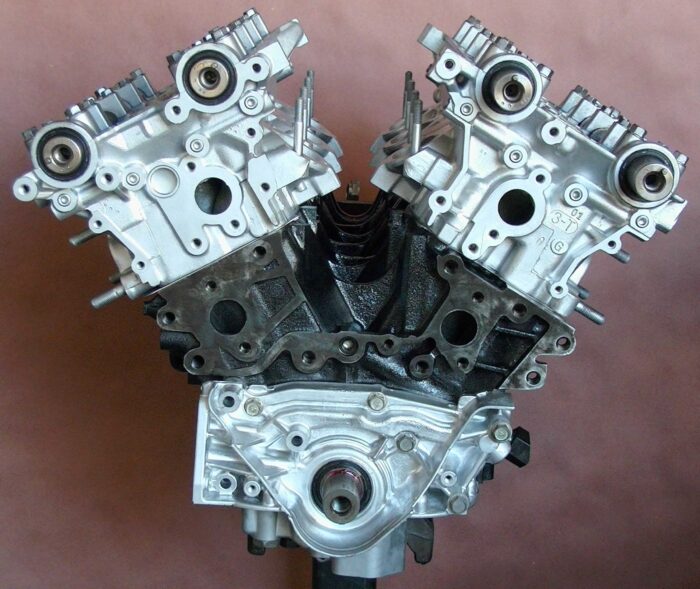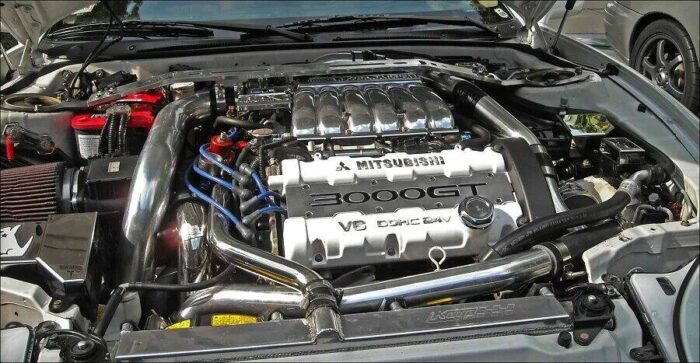The 3.0-liter Mitsubishi 6G72 V6 engine has proven to be a dependable and powerful force in the auto industry since its production began at the Kyoto plant in 1986. Ranging from Japanese models to Dodge and Chrysler, as well as Hyundai’s G6AT, this engine model is available in various modifications, including turbocharged versions. The 6G7 family also consists of other models like 6G71, 6G72TT, 6G73, 6G74 and 6G75.
Each modification is equipped with different technical characteristics attuned to the customer’s needs and requirements. As such, the engagement of the Mitsubishi 6G72 V6 engine across multiple industries over three decades has been monumental in engineering advancements and efficient performance.
Engine specifications for Mitsubishi 6G72 3.0 l
Modification 6G72 MPI SOHC 12V:
| Configuration |
V |
| Number of cylinders |
6 |
| Number of valves |
12 |
| Displacement |
2972 cc |
| Cylinder diameter |
91.1 mm |
| Stroke |
76 mm |
| Power system |
Distributor Injection System |
| Engine power |
140 – 160 hp |
| Torque |
230 – 250 Nm |
| Compression ratio |
9.0 |
| Fuel type |
Regular |
| Euro class |
EURO 2 |
Modification 6G72 MPI SOHC 24V:
| Configuration |
V |
| Number of cylinders |
6 |
| Number of valves |
24 |
| Displacement |
2972 cc |
| Cylinder diameter |
91.1 mm |
| Stroke |
76 mm |
| Power system |
Distributor Injection System |
| Engine power |
170 – 185 hp |
| Torque |
255 – 265 Nm |
| Compression ratio |
9.0 |
| Fuel type |
Regular |
| Euro class |
EURO 3 |
Modification 6G72 MPI DOHC 24V:
| Configuration |
V |
| Number of cylinders |
6 |
| Number of valves |
24 |
| Displacement |
2972 cc |
| Cylinder diameter |
91.1 mm |
| Stroke |
76 mm |
| Power system |
Distributor Injection System |
| Engine power |
195 – 225 hp |
| Torque |
265 – 280 Nm |
| Compression ratio |
10 |
| Fuel type |
Regular |
| Euro class |
EURO 3/4 |
Modification 6G72 GDI DOHC 24V:
| Configuration |
V |
| Number of cylinders |
6 |
| Number of valves |
24 |
| Displacement |
2972 cc |
| Cylinder diameter |
91.1 mm |
| Stroke |
76 mm |
| Power system |
Direct Injection |
| Engine power |
215 – 240 hp |
| Torque |
300 – 305 Nm |
| Compression ratio |
11 |
| Fuel type |
Medium/Plus |
| Euro class |
EURO 5 |
The dry weight of the 6G72 engine is 195 kg
Engine 6G72 3.0 l info
In 1986, the first modification of the V-shaped power unit appeared under the name 6G72. It was a classical V6 engine with 60° camber, cast iron block and a pair of aluminum SOHC 12-valve heads with hydro-compensators. It also used a fuel injection system and belt-driven timing belt.
In 1989, two revamped versions of this petrol engine debuted: the first was equipped with a pair of SOHC-heads, but with 24 valves, while the second, more classic 24-valve version had a pair of DOHC-heads. There was a version of the engine 6G72TT with twin-turbocharger, but it is a separate article.
The engine number 6G72 is located at the junction of the engine and gearbox.
The Japanese market offered a rare version of this motor with GDi direct fuel injection, as well as a version equipped with the proprietary MIVEC variable valve timing system.

Fuel consumption 6G72
1995 Mitsubishi Pajero with a manual transmission as an example (l/100km):
| City |
19.7 l |
| Highway |
11.2 l |
| Combined |
14.5 l |
What cars have the Mitsubishi 6G72
Mitsubishi
| 3000GT 1 (Z16) |
1990 – 1993 |
| 3000GT 2 (Z15) |
1993 – 2000 |
| Diamante 1 (F1) |
1990 – 1996 |
| Diamante 2 (F3) |
1995 – 2002 |
| Galant 8 (EA) |
1999 – 2003 |
| Eclipse 3 (D5) |
1999 – 2005 |
| L200 2 (K10) |
1986 – 1996 |
| L200 3 (K70) |
1996 – 2006 |
| Pajero 1 (L040) |
1988 – 1991 |
| Pajero 2 (V30) |
1991 – 2000 |
| Pajero 3 (V70) |
1999 – 2006 |
| Pajero 4 (V90) |
2006 – 2018 |
| Pajero Sport 1 (K90) |
1996 – 2008 |
| Delica 4 (PA) |
1994 – 2007 |

Chrysler
| New Yorker 13 |
1988 – 1989 |
| Town & Country 1 (AS) |
1989 – 1990 |
Dodge
| Caravan 1 (AS) |
1987 – 1990 |
| Caravan 2 (ES) |
1990 – 1995 |
| Caravan 3 (GS) |
1996 – 2000 |
| Stratus 2 (JR) |
2000 – 2005 |
| Stealth 1 (Z16A) |
1990 – 1993 |
| Stealth 2 (Z15A) |
1993 – 1996 |
Reviews on the engine 6G72 its pros and cons
Advantages:
- The unit is not very picky about fuel
- There are no weaknesses in the design
- There is a choice of new or used parts
- Hydro-compensators are provided here
Disadvantages:
- Fuel consumption is not to everyone’s liking
- Frequent antifreeze leaks
- Usually consumes oil by 200,000 km
- Bends valves with timing belt failures
Maintenance intervals for 6G72 3.0 l engines
Oil Service
| Interval |
Every 15 000 km |
| Oil caoacity |
5.5 l |
| Need to change |
4.7 l |
| Type of oil |
5W-30, 5W-40 |
Timing gear
| Timing Chain Type |
Belt |
| Service life |
90 000 km |
| In practice |
120 000 km |
| At breakage/trans-skip |
Bending of valves |
Valve clearances
| Re-adjustment |
not required |
| Adjustment principle |
hydrocompensators |
Service
| Oil filter |
15 000 km |
| Air filter |
30 000 km |
| Fuel filter |
60 000 km |
| Spark plugs |
30 000 km |
| Drive belt |
90 000 km |
| Coolant |
4 years or 60 000 km |
Problems & disadvantages of the Engine 6G72
- Poor engine performance? First, ensure good quality fuel is being used and replace the spark plugs to restore optimal operation. In other cases, it may be necessary to remove and grind the intake manifold for a complete resolution.
- A floating engine speed could be indicative of a need to inspect and possibly adjust or replace the idle speed control system. Additionally, if rpm continues to fluctuate beyond normal parameters, it is advised that an assessment of the throttle valve for maintenance should be conducted.
- In the event of noticing slight tapping noises within the 6G72 engine block, it is advisable to start by assessing the hydraulic lifters, as this likely indicates a need for replacement. To replace them, it is necessary to take off the valve cover. In rare cases, these audible signs may be because of a rotation of connecting rod bushings and would then require an expense-heavy overhaul in order to repair.
- Diagnosing a power loss can be difficult, and often leads to extensive servicing. After the initial inspection for compression levels is complete, it may become necessary to open up the motor in order to identify any damaged components that must be replaced or repaired.
The manufacturer has stated the engine life of the 6G72 in 200,000 km, but it serves up to 400,000 km.

6G72 Tuning
Chip tuning can be very effective in increasing the performance of a 6G72 engine, with up to 20 extra horsepower being achievable. For those looking for more extreme tuning options, turbocharging and front-mounted intercoolers can provide an even bigger power boost. The fuel pump must be replaced, while a new boost controller and other elements must all be correctly installed. Doing this correctly can raise the engine’s power to the level of 400 horsepower at a turbine pressure of 1 bar. Various chip tuning kits are available online that provide suitable options for any budget and application.
Summary
This Japanese automaker has been continuously optimizing its 6G72 engine models year after year, resulting in a variety of customized options that are simple to operate and reliable. Despite such advantages, the power unit is designed so if the belt breaks it can cause costly repairs due to piston collision with valves – regular maintenance including timing belt replacement should be done every 90 000 km for optimal performance. Although oil consumption tends to higher in older cars, overall this model series proved itself as quite successful.



0 Comments